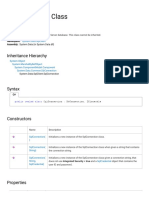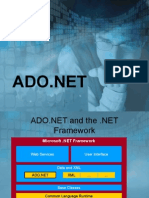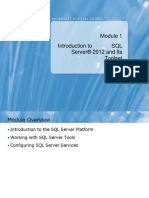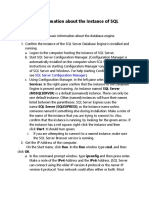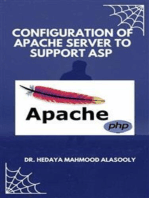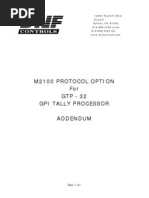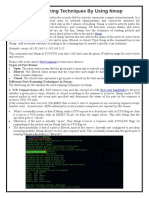SQL Server 2008 Connection String Samples - Connection Strings
Uploaded by
FlacoMetaleroSQL Server 2008 Connection String Samples - Connection Strings
Uploaded by
FlacoMetaleroSQL Server 2008 Connection String Samples - ConnectionStrings.
com
http://www.connectionstrings.com/sql-server-2008
Developers community number 1 connection string reference
Reference
Articles
Forums
Contributors
About
Retro
Advertise
DataFlex ODBC Driver Easy SQL direct access to DataFlex database tables with Windows apps. www.flexquarters.com SQL Database Designer Design, visualize, document and reverse engineer any database. www.modelright.com/ Database tool for MS SQL Graphical SQL Server Management, DB visual design tools,database editor www.sqlmanager.net/products/MSSQL
Connection strings for SQL Server 2008
Providers for SQL Server 2008 .NET Framework Data Provider for SQL Server (SqlConnection) SQL Server Native Client 10.0 OLE DB Provider .NET Framework Data Provider for OLE DB (OleDbConnection) SQL Server Native Client 10.0 ODBC Driver .NET Framework Data Provider for ODBC (OdbcConnection) SQLXML 4.0 OLEDB Provider Context Connection Community Forums Find solutions and post questions regarding connection string related issues. Forum for SQL Server 2008 >>
Sign-in | Join
Share
Se l e c te d Ar ti c l e s
What is a connection string? Rules for connection strings All SQL Server SqlConnection properties SQL Server Data Types Reference
. N E T F r a m e w o r k D a t a P r ov id e r f o r S QL S e r v e r
Type: .NET Framework Class Library Usage: System.Data.SqlClient.SqlConnection Manufacturer: Microsoft More info about this class library Customize string example values
Standard Security
Data Source = myServerAddress; Initial Catalog = myDataBase; User Id = myUsername; Password = myPassword;
Use serverName\instanceName as Data Source to connect to a specific SQL Server instance. Are you using SQL Server 2008 Express? Don't miss the server name syntax Servername\SQLEXPRESS where you substitute Servername with the name of the computer where the SQL Server Express installation resides.
Standard Security alternative syntax
This connection string produce the same result as the previous one. The reason to include it is to point out that some connection string keywords have many equivalents.
Server = myServerAddress; Database = myDataBase; User ID = myUsername; Password = myPassword; Trusted_Connection = False;
Trusted Connection
Data Source = myServerAddress; Initial Catalog = myDataBase; Integrated Security = SSPI;
Trusted Connection alternative syntax
This connection string produce the same result as the previous one. The reason to include it is to point out that some connection string keywords have many equivalents.
Server = myServerAddress; Database = myDataBase; Trusted_Connection = True;
Connecting to an SQL Server instance
The syntax of specifying the server instance in the value of the server key is the same for all connection strings for SQL Server.
Server = myServerName\theInstanceName; Database = myDataBase; Trusted_Connection = True;
Trusted Connection from a CE device
Often a Windows CE device is not authenticated and logged in to a domain. To use SSPI or trusted connection / authentication from a CE device, use this connection string.
Data Source = myServerAddress; Initial Catalog = myDataBase; Integrated Security = SSPI; User ID = myDomain\myUsername; Password = myPassword;
Note that this will only work on a CE device. Read more about connecting to SQL Server from CE devices here
1 de 5
16/04/2011 03:41 p.m.
SQL Server 2008 Connection String Samples - ConnectionStrings.com
http://www.connectionstrings.com/sql-server-2008
Connect via an IP address
Data Source = 190.190.200.100,1433; Network Library = DBMSSOCN; Initial Catalog = myDataBase; User ID = myUsername; Password = myPassword;
DBMSSOCN=TCP/IP. This is how to use TCP/IP instead of Named Pipes. At the end of the Data Source is the port to use. 1433 is the default port for SQL Server. How to define which network protocol to use
Enabling MARS (multiple active result sets)
Server = myServerAddress; Database = myDataBase; Trusted_Connection = True; MultipleActiveResultSets = true;
Use ADO.NET for MARS functionality. MARS is not supported in ADO.NET 1.0 nor ADO.NET 1.1. Streamline your Data Connections by Moving to MARS, by Laurence Moroney, DevX.com
Attach a database file on connect to a local SQL Server Express instance
Server = .\SQLExpress; AttachDbFilename = c:\asd\qwe\mydbfile.mdf; Database = dbname; Trusted_Connection = Yes;
Why is the Database parameter needed? If the named database have already been attached, SQL Server does not reattach it. It uses the attached database as the default for the connection.
Attach a database file, located in the data directory, on connect to a local SQL Server Express instance
Server = .\SQLExpress; AttachDbFilename = |DataDirectory|mydbfile.mdf; Database = dbname; Trusted_Connection = Yes;
Why is the Database parameter needed? If the named database have already been attached, SQL Server does not reattach it. It uses the attached database as the default for the connection.
Using an User Instance on a local SQL Server Express instance
The User Instance functionality creates a new SQL Server instance on the fly during connect. This works only on a local SQL Server instance and only when connecting using windows authentication over local named pipes. The purpose is to be able to create a full rights SQL Server instance to a user with limited administrative rights on the computer.
Data Source = .\SQLExpress; Integrated Security = true; AttachDbFilename = |DataDirectory|\mydb.mdf; User Instance = true;
To use the User Instance functionality you need to enable it on the SQL Server. This is done by executing the following command: sp_configure 'user instances enabled', '1'. To disable the functionality execute sp_configure 'user instances enabled', '0'.
Database mirroring
If you connect with ADO.NET or the SQL Native Client to a database that is being mirrored, your application can take advantage of the drivers ability to automatically redirect connections when a database mirroring failover occurs. You must specify the initial principal server and database in the connection string and the failover partner server.
Data Source = myServerAddress; Failover Partner = myMirrorServerAddress; Initial Catalog = myDataBase; Integrated Security = True;
There is ofcourse many other ways to write the connection string using database mirroring, this is just one example pointing out the failover functionality. You can combine this with the other connection strings options available.
Asynchronous processing
A connection to SQL Server that allows for the issuing of async requests through ADO.NET objects.
Server = myServerAddress; Database = myDataBase; Integrated Security = True; Asynchronous Processing = True;
S QL S e r v e r N at iv e C lie n t 1 0 . 0 OL E D B Pr ov id e r
Type: OLE DB Provider Usage: Provider=SQLNCLI10 Manufacturer: Microsoft More info about this provider Customize string example values
Standard security
2 de 5
16/04/2011 03:41 p.m.
SQL Server 2008 Connection String Samples - ConnectionStrings.com
http://www.connectionstrings.com/sql-server-2008
Provider = SQLNCLI10; Server = myServerAddress; Database = myDataBase; Uid = myUsername; Pwd = myPassword;
Are you using SQL Server 2008 Express? Don't miss the server name syntax Servername\SQLEXPRESS where you substitute Servername with the name of the computer where the SQL Server 2008 Express installation resides.
Trusted connection
Provider = SQLNCLI10; Server = myServerAddress; Database = myDataBase; Trusted_Connection = yes;
Equivalent key-value pair: "Integrated Security=SSPI" equals "Trusted_Connection=yes"
Connecting to an SQL Server instance
The syntax of specifying the server instance in the value of the server key is the same for all connection strings for SQL Server.
Provider = SQLNCLI10; Server = myServerName\theInstanceName; Database = myDataBase; Trusted_Connection = yes;
Prompt for username and password
This one is a bit tricky. First you need to set the connection object's Prompt property to adPromptAlways. Then use the connection string to connect to the database.
oConn.Properties("Prompt") = adPromptAlways oConn.Open "Provider = SQLNCLI10; Server = myServerAddress; DataBase = myDataBase;
Enabling MARS (multiple active result sets)
Provider = SQLNCLI10; Server = myServerAddress; Database = myDataBase; Trusted_Connection = yes; MARS Connection = True;
Use ADO.NET for MARS functionality. MARS is not supported in ADO.NET 1.0 nor ADO.NET 1.1. Using MARS with SQL Native Client, by Chris Lee
Encrypt data sent over network
Provider = SQLNCLI10; Server = myServerAddress; Database = myDataBase; Trusted_Connection = yes; Encrypt = yes;
Attach a database file on connect to a local SQL Server Express instance
Provider = SQLNCLI10; Server = .\SQLExpress; AttachDbFilename = c:\asd\qwe\mydbfile.mdf; Database = dbname; Trusted_Connection = Yes;
Why is the Database parameter needed? If the named database have already been attached, SQL Server does not reattach it. It uses the attached database as the default for the connection.
Attach a database file, located in the data directory, on connect to a local SQL Server Express instance
Provider = SQLNCLI10; Server = .\SQLExpress; AttachDbFilename = |DataDirectory|mydbfile.mdf; Database = dbname; Trusted_Connection = Yes;
Why is the Database parameter needed? If the named database have already been attached, SQL Server does not reattach it. It uses the attached database as the default for the connection.
Database mirroring
If you connect with ADO.NET or the SQL Native Client to a database that is being mirrored, your application can take advantage of the drivers ability to automatically redirect connections when a database mirroring failover occurs. You must specify the initial principal server and database in the connection string and the failover partner server.
Provider = SQLNCLI10; Data Source = myServerAddress; Failover Partner = myMirrorServerAddress; Initial Catalog = myDataBase; Integrated Security = True;
There is ofcourse many other ways to write the connection string using database mirroring, this is just one example pointing out the failover functionality. You can combine this with the other connection strings options available.
. N E T F r a m e w o r k D a t a P r ov id e r f o r O L E D B
Type: .NET Framework Wrapper Class Library Usage: System.Data.OleDb.OleDbConnection Manufacturer: Microsoft More info about this wrapper class library Customize string example values
Bridging to SQL Native Client OLE DB
This is just one connection string sample for the wrapping OleDbConnection class that calls the underlying OLEDB provider. See respective OLE DB provider for more connection strings to use with this class.
Provider = SQLNCLI10; Server = myServerAddress; Database = myDataBase; Uid = myUsername; Pwd = myPassword;
S QL S e r v e r N at iv e C lie n t 1 0 . 0 OD B C D r iv e r
Type: ODBC Driver Usage: Driver={SQL Server Native Client 10.0} Manufacturer: Microsoft More info about this driver Customize string example values
3 de 5
16/04/2011 03:41 p.m.
SQL Server 2008 Connection String Samples - ConnectionStrings.com
http://www.connectionstrings.com/sql-server-2008
Standard security
Driver = {SQL Server Native Client 10.0}; Server = myServerAddress; Database = myDataBase; Uid = myUsername; Pwd = myPassword;
Are you using SQL Server 2008 Express? Don't miss the server name syntax Servername\SQLEXPRESS where you substitute Servername with the name of the computer where the SQL Server 2008 Express installation resides.
Trusted Connection
Driver = {SQL Server Native Client 10.0}; Server = myServerAddress; Database = myDataBase; Trusted_Connection = yes;
Equivalent key-value pair: "Integrated Security=SSPI" equals "Trusted_Connection=yes"
Connecting to an SQL Server instance
The syntax of specifying the server instance in the value of the server key is the same for all connection strings for SQL Server.
Driver = {SQL Server Native Client 10.0}; Server = myServerName\theInstanceName; Database = myDataBase; Trusted_Connection = yes;
Prompt for username and password
This one is a bit tricky. First you need to set the connection object's Prompt property to adPromptAlways. Then use the connection string to connect to the database.
oConn.Properties("Prompt") = adPromptAlways Driver = {SQL Server Native Client 10.0}; Server = myServerAddress; Database = myDataBase;
Enabling MARS (multiple active result sets)
Driver = {SQL Server Native Client 10.0}; Server = myServerAddress; Database = myDataBase; Trusted_Connection = yes; MARS_Connection = yes;
Use ADO.NET for MARS functionality. MARS is not supported in ADO.NET 1.0 nor ADO.NET 1.1. Using MARS with SQL Native Client, by Chris Lee
Encrypt data sent over network
Driver = {SQL Server Native Client 10.0}; Server = myServerAddress; Database = myDataBase; Trusted_Connection = yes; Encrypt = yes;
Attach a database file on connect to a local SQL Server Express instance
Driver = {SQL Server Native Client 10.0}; Server = .\SQLExpress; AttachDbFilename = c:\asd\qwe\mydbfile.mdf; Database = dbname; Trusted_Connection = Yes;
Why is the Database parameter needed? If the named database have already been attached, SQL Server does not reattach it. It uses the attached database as the default for the connection.
Attach a database file, located in the data directory, on connect to a local SQL Server Express instance
Driver = {SQL Server Native Client 10.0}; Server = .\SQLExpress; AttachDbFilename = |DataDirectory|mydbfile.mdf; Database = dbname; Trusted_Connection = Yes;
Why is the Database parameter needed? If the named database have already been attached, SQL Server does not reattach it. It uses the attached database as the default for the connection.
Database mirroring
If you connect with ADO.NET or the SQL Native Client to a database that is being mirrored, your application can take advantage of the drivers ability to automatically redirect connections when a database mirroring failover occurs. You must specify the initial principal server and database in the connection string and the failover partner server.
Driver = {SQL Server Native Client 10.0}; Server = myServerAddress; Failover_Partner = myMirrorServerAddress; Database = myDataBase; Trusted_Connection = yes;
There is ofcourse many other ways to write the connection string using database mirroring, this is just one example pointing out the failover functionality. You can combine this with the other connection strings options available. Please note if you are using TCP/IP (using the network library parameter) and database mirroring, including port number in the address (formed as servername,portnumber) for booth the main server and the failover partner can solve some reported issues.
. N E T F r a m e w o r k D a t a P r ov id e r f o r O D B C
Type: .NET Framework Wrapper Class Library Usage: System.Data.Odbc.OdbcConnection Manufacturer: Microsoft More info about this wrapper class library Customize string example values
Bridging to SQL Native Client 10.0 ODBC Driver
This is just one connection string sample for the wrapping OdbcConnection class that calls the underlying ODBC Driver. See respective ODBC driver for more connection strings to use with this class.
Driver = {SQL Server Native Client 10.0}; Server = myServerAddress; Database = myDataBase; Uid = myUsername; Pwd = myPassword;
4 de 5
16/04/2011 03:41 p.m.
SQL Server 2008 Connection String Samples - ConnectionStrings.com
http://www.connectionstrings.com/sql-server-2008
S QL X M L 4 . 0 O L E D B Pr o v id e r
Type: OLE DB Provider Usage: Provider=SQLXMLOLEDB.4.0;Data Provider=providername Manufacturer: Microsoft More info about this provider Customize string example values
Using SQL Server Native Client provider
Provider = SQLXMLOLEDB.4.0; Data Provider = SQLNCLI10; Data Source = myServerAddress; Initial Catalog = myDataBase; User Id = myUsername; Password = myPassword;
C o n t e x t C o n n e c t i on
Type: .NET Framework Class Library Usage: Manufacturer: Microsoft More info about this class library Customize string example values
Context Connection
Connecting to "self" from within your CLR stored prodedure/function. The context connection lets you execute Transact-SQL statements in the same context (connection) that your code was invoked in the first place.
C# using(SqlConnection connection = new SqlConnection("context connection=true")) { connection.Open(); // Use the connection } VB.Net Using connection as new SqlConnection("context connection=true") connection.Open() ' Use the connection End Using
When to use SQL Native Client? List of all SqlConnection connection string properties
Copyright 2011 ConnectionStrings.com
All Rights Reserved
Powered by CSAS
Send feedback, articles, requests and more connection strings here.
5 de 5
16/04/2011 03:41 p.m.
You might also like
- Official Microsoft Learning Product 20461C Querying Microsoft SQL Server100% (2)Official Microsoft Learning Product 20461C Querying Microsoft SQL Server78 pages
- JSP-Servlet Interview Questions You'll Most Likely Be AskedFrom EverandJSP-Servlet Interview Questions You'll Most Likely Be AskedNo ratings yet
- Connection Strings For SQL Server 2005: The Reference Articles Contributors MagazinesNo ratings yetConnection Strings For SQL Server 2005: The Reference Articles Contributors Magazines11 pages
- SqlConnection Class (System - data.SqlClient)100% (1)SqlConnection Class (System - data.SqlClient)8 pages
- SPANISH - Beginners Guide To Accessing SQL Server Through C#No ratings yetSPANISH - Beginners Guide To Accessing SQL Server Through C#14 pages
- Lesson 02: The Sqlconnection Object: Connection String Parameter Name DescriptionNo ratings yetLesson 02: The Sqlconnection Object: Connection String Parameter Name Description3 pages
- Beginners Guide To Accessing SQL Server Through CNo ratings yetBeginners Guide To Accessing SQL Server Through C8 pages
- Microsoft SQL Azure Enterprise Application DevelopmentFrom EverandMicrosoft SQL Azure Enterprise Application DevelopmentNo ratings yet
- DBMS/RDBMS Database Server Connection StringsNo ratings yetDBMS/RDBMS Database Server Connection Strings18 pages
- Lect 5 - Database Integration With Visual StudioNo ratings yetLect 5 - Database Integration With Visual Studio12 pages
- Understanding SQL Server Configuration Manager - CodeProjectNo ratings yetUnderstanding SQL Server Configuration Manager - CodeProject6 pages
- Introduction To SQL Server® 2012 and Its Toolset100% (1)Introduction To SQL Server® 2012 and Its Toolset28 pages
- Beginners Guide To Accessing SQL Server Through C #No ratings yetBeginners Guide To Accessing SQL Server Through C #8 pages
- How To Connect Remotely To A SQL-Server Database: National Park ServiceNo ratings yetHow To Connect Remotely To A SQL-Server Database: National Park Service23 pages
- Delphi - Connect To Microsoft SQL Server (FireDAC) - RAD StudioNo ratings yetDelphi - Connect To Microsoft SQL Server (FireDAC) - RAD Studio9 pages
- Connection String For Connecting To Data Sources in VB100% (3)Connection String For Connecting To Data Sources in VB10 pages
- Introduction To SQL Introduction To SQL Server® 2012 and Its ToolsetNo ratings yetIntroduction To SQL Introduction To SQL Server® 2012 and Its Toolset30 pages
- Connect SQL Database To Your C# Program: Domainaced byNo ratings yetConnect SQL Database To Your C# Program: Domainaced by9 pages
- What is SQL Server_ Introduction, History, Types, VersionsNo ratings yetWhat is SQL Server_ Introduction, History, Types, Versions11 pages
- System - Data.Dll System - XML.DLL.: Sqlconnection ConstructorsNo ratings yetSystem - Data.Dll System - XML.DLL.: Sqlconnection Constructors6 pages
- How To Connect To SQL Server From Visual FoxProNo ratings yetHow To Connect To SQL Server From Visual FoxPro4 pages
- ASP .Net Database Connectivity PresentationNo ratings yetASP .Net Database Connectivity Presentation18 pages
- Introduction To Microsoft SQL Server 2014: Module OverviewNo ratings yetIntroduction To Microsoft SQL Server 2014: Module Overview16 pages
- Configuring Microsoft SQL Server 2005 LiNo ratings yetConfiguring Microsoft SQL Server 2005 Li14 pages
- Lab - Using Wireshark To Examine A UDP DNS Capture: (Instructor Version)No ratings yetLab - Using Wireshark To Examine A UDP DNS Capture: (Instructor Version)7 pages
- Waveshare RS485 To Ethernet Converter For EU100% (1)Waveshare RS485 To Ethernet Converter For EU26 pages
- Simple PLC To PLC Communications iQ-R Master To iQ-F SlaveNo ratings yetSimple PLC To PLC Communications iQ-R Master To iQ-F Slave7 pages
- STULZ Controller Communication Manual OCU0147100% (3)STULZ Controller Communication Manual OCU014728 pages
- Configuring The HPE Proliant DL380 Gen9 24-SFF CTO Server As A Vertica NodeNo ratings yetConfiguring The HPE Proliant DL380 Gen9 24-SFF CTO Server As A Vertica Node14 pages
- Teach Yourself TCP-IP in 14 Days (Unix)No ratings yetTeach Yourself TCP-IP in 14 Days (Unix)20 pages
- Stochastic Packet Inspection For TCP Traffic: Firstname - Lastname@enst - FR Firstname - Lastname@polito - ItNo ratings yetStochastic Packet Inspection For TCP Traffic: Firstname - Lastname@enst - FR Firstname - Lastname@polito - It6 pages
- What You Need To Know in Advance About Configuring The Comrex OpalNo ratings yetWhat You Need To Know in Advance About Configuring The Comrex Opal2 pages
- IBM Endpoint Manager For Remote Control Installation GuideNo ratings yetIBM Endpoint Manager For Remote Control Installation Guide144 pages
- Som (System On Module) Based Count Down Time Distribution and Reception UnitNo ratings yetSom (System On Module) Based Count Down Time Distribution and Reception Unit6 pages







